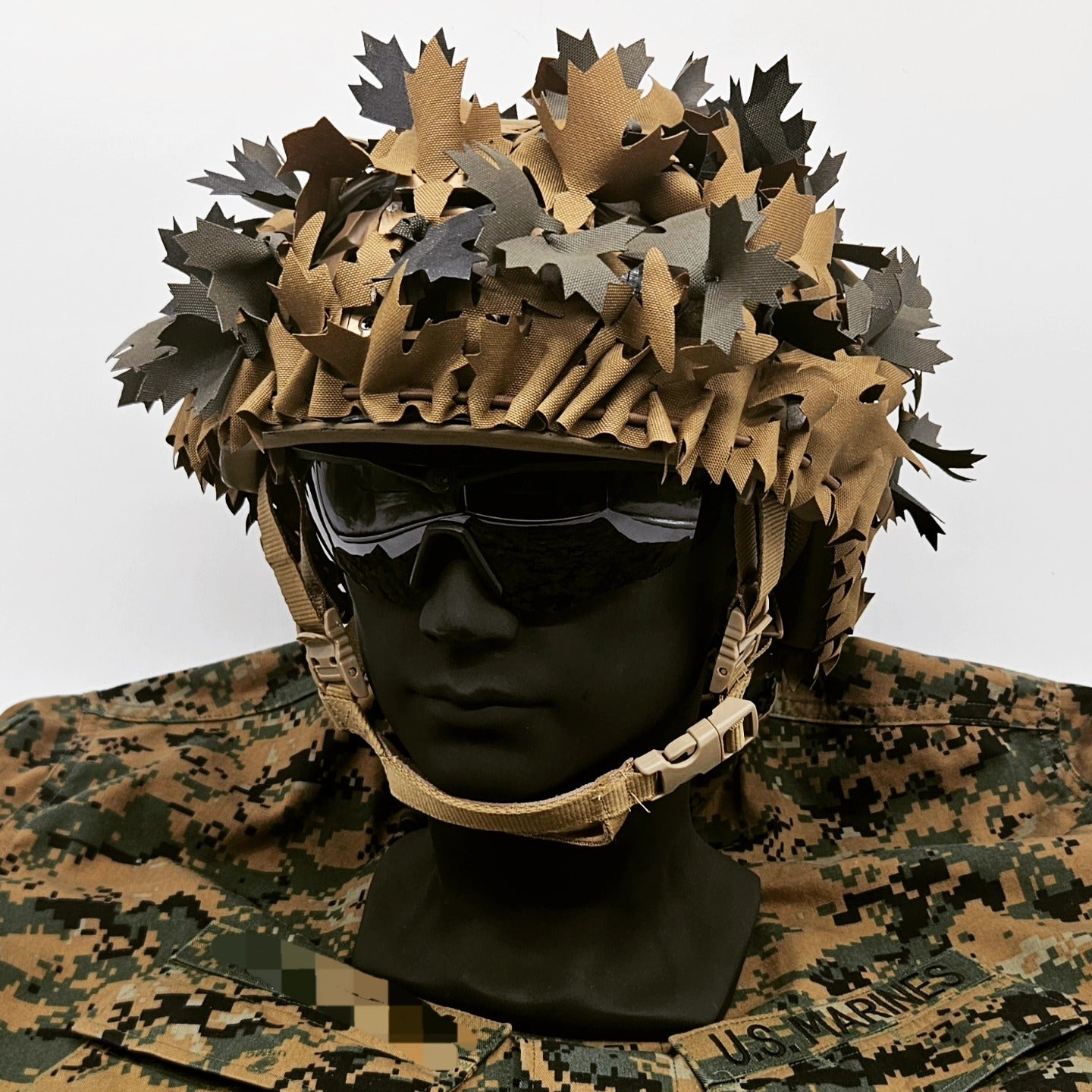Optical Camouflage: The Art of Disappearing from Eyes and Sensors
When Shadows Become Strategy | Optical Camouflage
Mist clings to the trees. Light flickers through the leaves, shifting with the wind. And there—still, silent—a shape merges with the trunks. No magic, only science. Optical camouflage turns presence into uncertainty, matter into illusion.
In modern warfare, blending into the environment has become a battle of its own. The enemy doesn’t just look — it scans, measures, analyzes. Thermal cameras, drones, satellites: they all search for the faintest irregularity.
Camouflage, then, is no longer clothing. It’s signature management a structure of light, heat, and deception. A way to exist without appearing.
From War Paint to Digital Skins: The Evolution of an Art | Optical Camouflage
Long before uniforms and nanotech, there was mud. Hunters smeared it across their skin to vanish into the land.
Then came the battlefields of the industrial age, and with them, the science of deception.
In the First World War, color became a liability. The red and blue of 19th-century armies turned soldiers into targets. Earth tones replaced glory.
France even created a special unit — the Camoufleurs: painters, sculptors, artists transforming guns and vehicles into visual riddles.
From then on, concealment became a discipline.
World War II elevated it to a system. Each theater — jungle, desert, tundra — required its own palette, pattern, and illusion. Camouflage became disruptive, designed not to imitate nature, but to confuse human perception.
Then came machines that see beyond sight: infrared binoculars, thermal imagers, radar. The human eye was no longer the only judge.
To hide now meant to hide from the invisible spectrum.
Camouflage evolved into the multi-spectral:
- visible,
- infrared,
- and thermal.
War entered the realm of photons and pixels.
Visual Illusion: When the Brain Becomes the Target | Optical Camouflage
To fool the eye, you must fool the mind. What the eye sees, the brain interprets. What it interprets, it believes.
Optical camouflage exploits that gap — breaking shapes, scattering light, corrupting depth.
A good pattern fractures the body’s outline, splinters its geometry, and makes it float between background layers. The brain can’t reassemble it. It stares, but it doesn’t recognize.
Color alone doesn’t win. Light does.
A polished surface betrays. A metal glint calls attention. A shadow cast wrong gives everything away.
That’s why modern materials are matte, rough, textured. They absorb light, scatter reflections, and blend into visual noise.
Camouflage is physics and psychology at once — the art of existing unrecognized.
The Invisible Enemy: Cameras, Drones, and Thermal Sensors | Optical Camouflage
Yesterday’s soldier feared the scope of a rifle.
Today, he fears the gaze of a sensor.
Surveillance technology detects what no human eye can — heat, moisture, radiation, reflection.
To survive, one must not only blend in but deceive the algorithm.
Infrared cameras capture thermal emissions. The human body, even motionless, glows in that spectrum.
Modern fabrics use thermoregulating fibers to absorb and redirect body heat, diffusing it toward the ground.
Near-infrared (NIR) sensors, meanwhile, detect subtle contrasts invisible to us. Some fabrics that look perfect in daylight blaze like torches under NIR. That’s why advanced uniforms use NIR-compliant dyes, reflecting light like foliage, not cotton.
Vehicles take camouflage even further: anti-radar coatings, nanostructured paints, 3D thermal nets with air pockets.
The science is geometric — a matter of angles, wavelengths, and thermal gradients.
Camouflage becomes mathematics: a game of probability between detection and disappearance.
Active Camouflage: When Matter Changes Its Skin | Optical Camouflage
Picture a tank that shifts color when it stops.
A combat suit that darkens at dusk.
A synthetic skin that ripples and adapts like a chameleon.
That’s not fantasy anymore. With nanotechnology and flexible displays, camouflage is turning active.
Electrochromic materials can alter hue within seconds. Some prototypes use micro-LCD panels to project live images of their surroundings.
Still fragile, still expensive — but they work.
Nature has done this forever: octopuses, cuttlefish, chameleons.
Their skin changes color, texture, even reflectivity to match the world around them.
Scientists now mimic those systems with responsive polymers and light-reactive nanostructures.
Camouflage begins to behave like a living organism — adaptive, intelligent, almost sentient.
The Core Principles: The Science of Disappearance | Optical Camouflage
Every successful optical camouflage relies on three pillars.
Visual mimicry.
Modern patterns like Multicam or CADPAT don’t replicate a single terrain. They reproduce the logic of natural vision — irregular patches, soft gradients, balanced contrasts. They don’t copy; they deceive.
Silhouette disruption.
The human outline is unmistakable. To shatter that familiarity, operators use ghillie suits, 3D leaf-cut systems, and fringed nets.
These break the symmetry, add texture, cast shadows — turning a man into an abstraction.
Light control.
Gloss kills concealment. Matteness saves it.
Advanced coatings diffuse light in every direction, reducing brightness without darkening the surface.
Camouflage, above all, is the management of luminance.
From Forest to Desert: Every Terrain Has Its Language | Optical Camouflage
In a deciduous forest, nothing stays still. Greens shift toward brown, shadows turn blue, sunlight dances. Effective patterns mix soft contrasts and layered tones.
In coniferous woods, vertical lines dominate — trunks repeating like columns. Colors cool down: deep green, stone gray, cold earth. A soldier aligns his form to theirs, extending the illusion upward.
The desert seems simple — endless sand. But its palette changes hourly.
The best desert camouflage blends beige, khaki, and gray with broken patches. And to survive infrared, fabric must breathe: an air pocket layer that prevents heat bloom.
In the city, geometry reigns. Straight lines, glass, concrete. The goal is to break symmetry, scatter reflections, and merge into the rhythm of walls.
Under snow, pure white betrays. It glows under sunlight. Real snow camouflage is off-white, gray, or dirty — just like nature after a few hours of wind.
Each environment dictates its own rules. The best camouflage doesn’t copy scenery — it copies light.
When Technology Meets Tactics | Optical Camouflage
Modern militaries no longer paint; they engineer.
They simulate reflectance curves, model shadow density, measure heat signatures.
Camouflage is now an algorithm of survival.
NIR-compliant fabrics, multi-spectral nets, and nano-coatings don’t make you invisible — they delay detection.
And in combat, a three-second delay can decide a life.
Some next-generation systems already combine sensors and adaptive materials. They analyze ambient light and suggest color adjustments in real time.
Camouflage becomes a sensor network, an interface between soldier and environment.
Maintenance: The Discipline Behind Stealth | Optical Camouflage
Even the best camouflage fails when it’s dirty or glossy.
A dusty net, a wet jacket, a peeling coating — all betray.
Veteran units know: maintenance equals invisibility.
Brush, rinse, repair. Avoid scented detergents. Keep surfaces matte, textures intact.
A clean, silent pattern is more effective than the most advanced tech left unkept.
Camouflage is order disguised as chaos.
The Future: Intelligent and Sustainable Invisibility
In laboratories, the next era of stealth is already materializing.
“Living” fabrics that respond to light.
Biodegradable polymers that alter texture with temperature.
AI systems that scan terrain and adjust color automatically.
Tomorrow’s camouflage won’t just hide — it will coexist.
It will merge into ecosystems, respect its surroundings, and function sustainably.
Stealth will become responsible invisibility — efficient, silent, ecological.
FAQ – Essential Questions
Q: What’s the difference between optical and thermal camouflage?
A: Optical hides visible light; thermal hides heat emissions. Together, they form true invisibility.
Q: Does active camouflage really exist?
A: Yes — prototypes with electrochromic films and flexible screens are under military testing. Still rare, but real.
Q: Can civilians use this technology?
A: Some gear is available for hunting, wildlife photography, and private security. Military-grade systems remain restricted.
Q: How do you test camouflage?
A: Observe it from multiple distances and light sources. If possible, test under infrared or thermal cameras. Truth lives in the spectrum.
Q: Is pure white ideal for snow?
A: Never. True snow camouflage is off-white and gray. Real snow isn’t perfect — and that’s why it hides you.
Conclusion: Disappearing to Reclaim the Advantage
Optical camouflage is more than fabric and paint. It’s language — a dialogue between light, matter, and perception.
Its purpose isn’t invisibility, but uncertainty.
In a world flooded with sensors, stealth has become an art of presence and absence.
To survive, one must learn to live between what’s seen and what’s believed.
Best regards,
The Nutsof Team
Advanced Camouflage & Defense Solutions
🌐 www.nutsof.com
Follow us on Facebook and Instagram for the latest in advanced military camouflage technologies.


